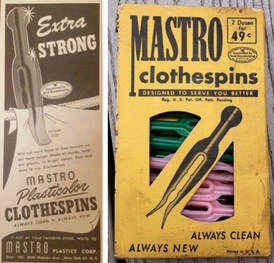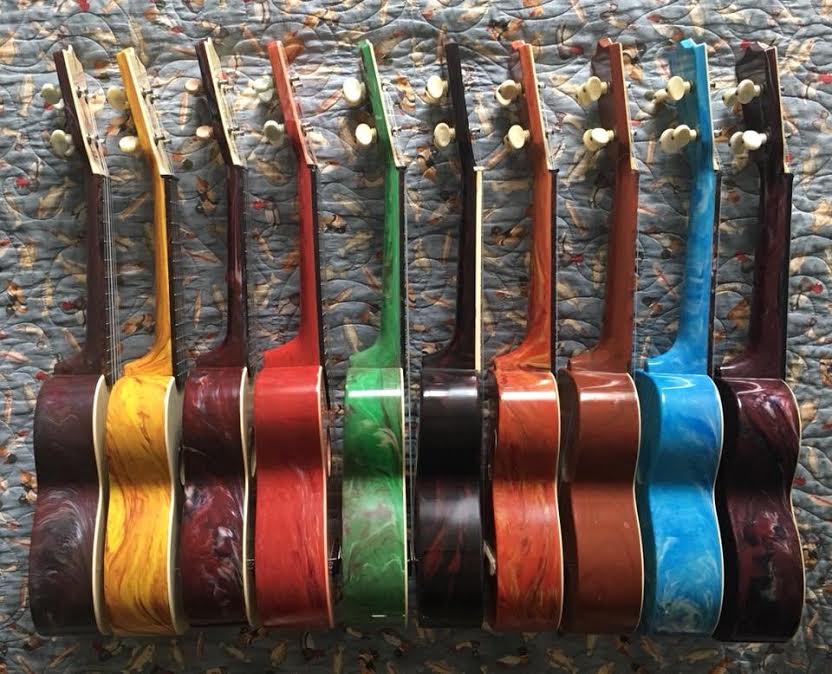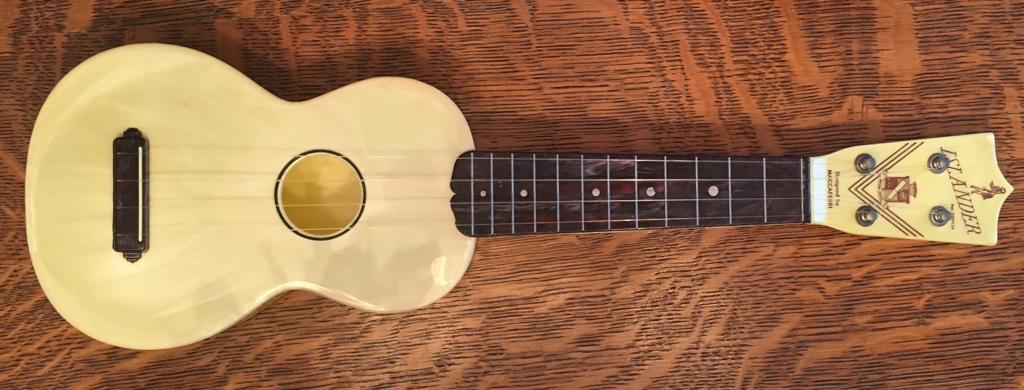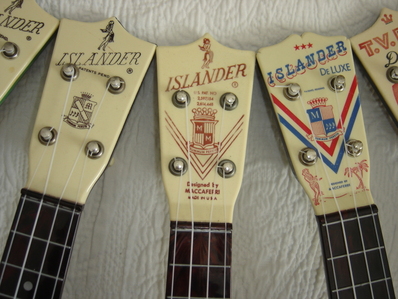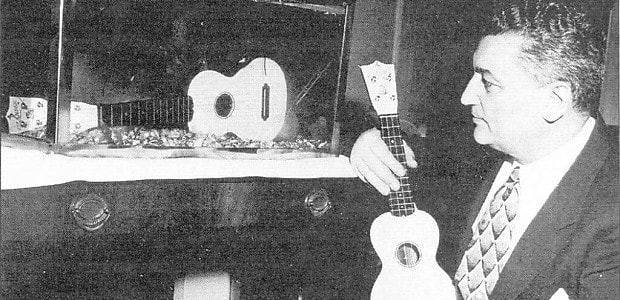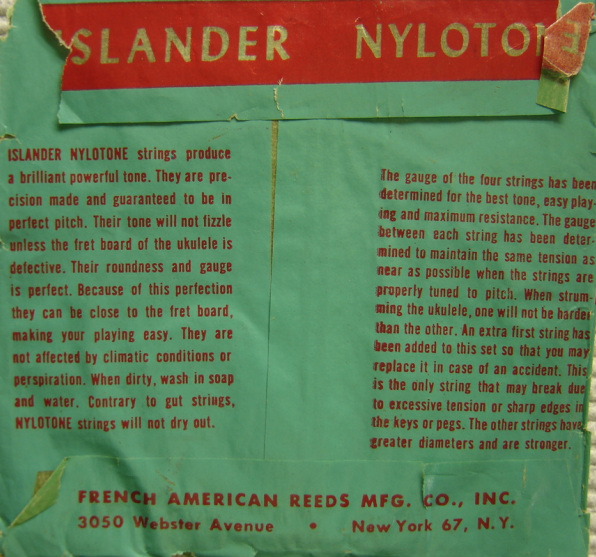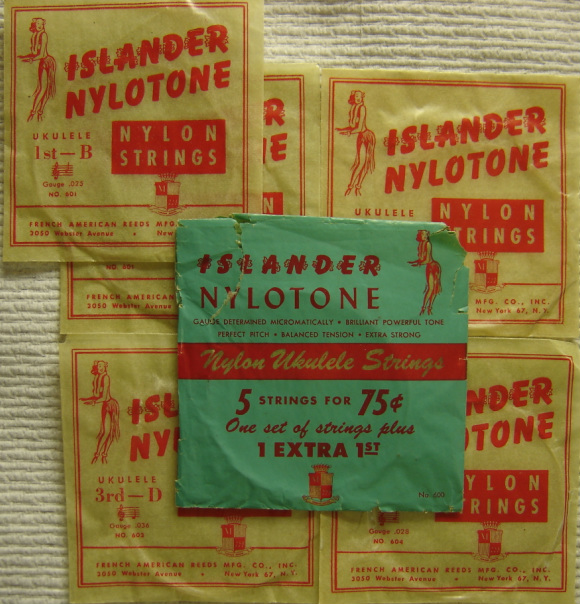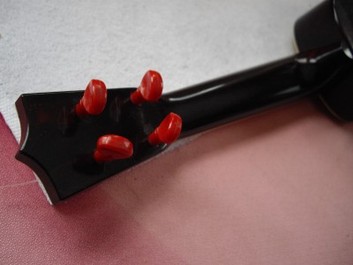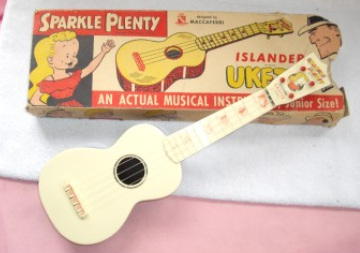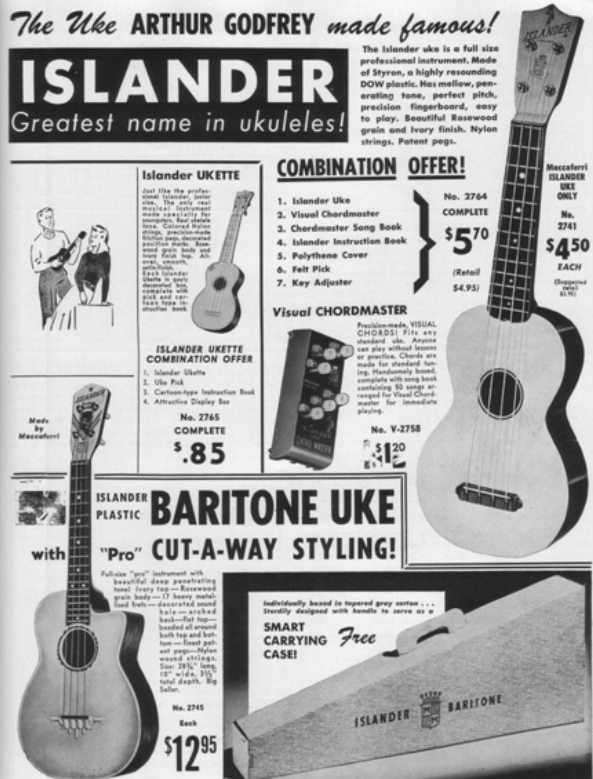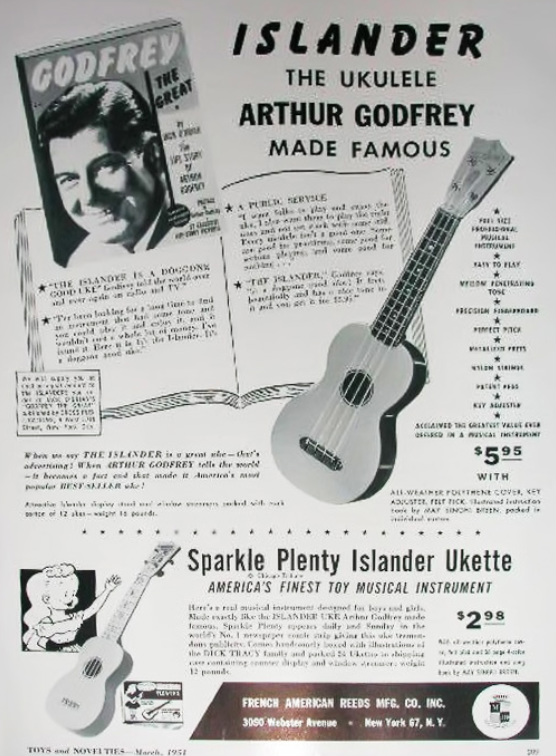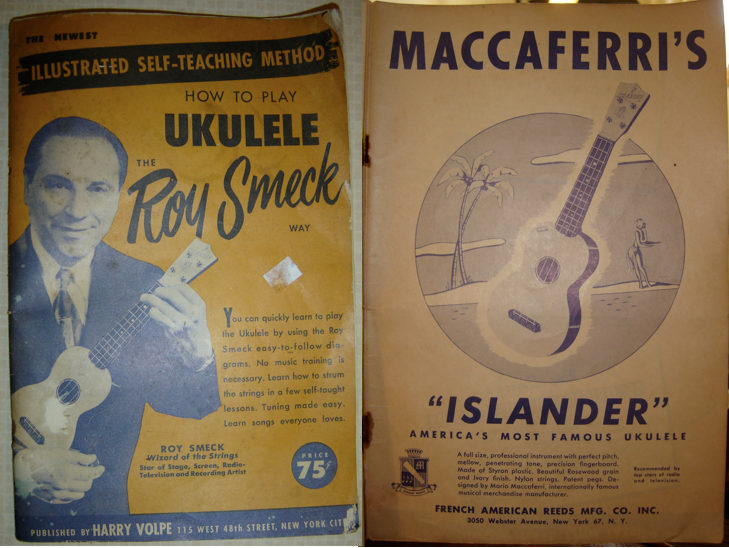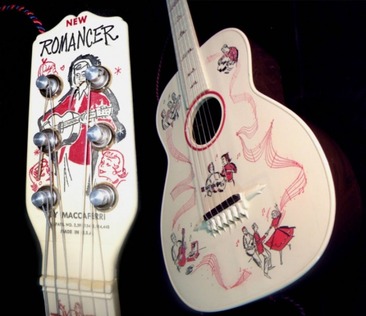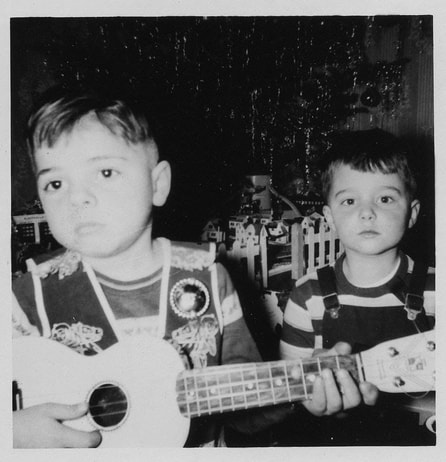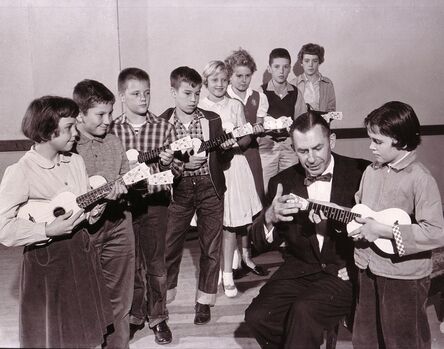Page Updated 12/5/21
A brief biography of Mario Maccaferri...

Mario Maccaferri was born in Cento, Italy in 1900. He became an apprentice at the age of 11 to Luigi Mozzani a master luthier and musician. Mario studied lutherie and the playing of classical guitar. Beginning in 1916, he studied ten years at the Conservatory at Sienna, where he graduated with highest honors and became a teacher. He pursued a career of guitar performance leaving lutherie temporarily.
In 1929, Maccaferri moved to London where along with performing concerts, he taught guitar. He always thought about ways to create a better guitar. The Davis brothers who managed Selmer's London dealership saw Maccaferri’s guitars and introduced him to Selmer, a guitar manufacturer. Selmer agreed to making Maccaferri’s design in his factory near Paris. In May of 1932, a patent was registered in Paris concerning the resonation chamber of the guitar.
Maccaferri wanted to tour and perform, but in 1933, he suffered a swimming accident which hurt his right hand. While he couldn’t perform as well as he used too he sometimes performed as the “Unknown Guitarist” wearing a mask.
Now that his professional playing career was over he started the French-American Reed Manufacturing Company. He had learned the skill of making reeds for woodwind instruments while at the Selmer manufacturing facility and in 1935 he filed for a patent for the way he made reeds. He set up a branch of that business in New York in 1939 to escape the war in France. His departure to the United States was truly miraculous as he was able to get on one of the last boats to leave France.
Because of war time shipping problems he was not able to get the material he needed to make reeds. While at the 1939 Worlds Fair he saw plastic as a material of the future. His business diversified into almost anything that could be made by injection molding- like clothespins and tiles and in the 1970’s 8-track and later cassette tape cases.
His sleeping luthier woke up in him - this time using plastic. 1949 saw the invention of the Islander ukulele. The popular entertainer Arthur Godfrey saw Maccaferri's Islander ukulele and gave it an endorsement as an affordable quality instrument and he refused any payment for that endorsement. It is reported that between 1949 and 1969, 9 million plastic ukuleles were sold. This success encouraged him to go back to the guitar, but guitarists did not take to plastics and his guitar was not a success. Around 1969 the musical instrument division of his business was sold to Carnival and his molds did not survive.
The type of plastic used in making his instruments was Styron. According to the Dow Chemical website this plastic has various formulas and is used to make food packaging, appliance parts, toys and medical items.
Mario was always seeing the possibilities of plastic. He even made a plastic violin which was played in Carnegie Hall in 1990.
When Mario decided to get out of the plastic business Maria talked him into keeping the reed business. Mario Maccaferri passed away in 1993 at the age of 92. Maria took full control of French American Reeds INC and it is still operating in Jackson, Tennessee under the leadership of daughter Eliane Reese.
The family has now created a website to archive this mans accomplishments. CLICK HERE
In 1929, Maccaferri moved to London where along with performing concerts, he taught guitar. He always thought about ways to create a better guitar. The Davis brothers who managed Selmer's London dealership saw Maccaferri’s guitars and introduced him to Selmer, a guitar manufacturer. Selmer agreed to making Maccaferri’s design in his factory near Paris. In May of 1932, a patent was registered in Paris concerning the resonation chamber of the guitar.
Maccaferri wanted to tour and perform, but in 1933, he suffered a swimming accident which hurt his right hand. While he couldn’t perform as well as he used too he sometimes performed as the “Unknown Guitarist” wearing a mask.
Now that his professional playing career was over he started the French-American Reed Manufacturing Company. He had learned the skill of making reeds for woodwind instruments while at the Selmer manufacturing facility and in 1935 he filed for a patent for the way he made reeds. He set up a branch of that business in New York in 1939 to escape the war in France. His departure to the United States was truly miraculous as he was able to get on one of the last boats to leave France.
Because of war time shipping problems he was not able to get the material he needed to make reeds. While at the 1939 Worlds Fair he saw plastic as a material of the future. His business diversified into almost anything that could be made by injection molding- like clothespins and tiles and in the 1970’s 8-track and later cassette tape cases.
His sleeping luthier woke up in him - this time using plastic. 1949 saw the invention of the Islander ukulele. The popular entertainer Arthur Godfrey saw Maccaferri's Islander ukulele and gave it an endorsement as an affordable quality instrument and he refused any payment for that endorsement. It is reported that between 1949 and 1969, 9 million plastic ukuleles were sold. This success encouraged him to go back to the guitar, but guitarists did not take to plastics and his guitar was not a success. Around 1969 the musical instrument division of his business was sold to Carnival and his molds did not survive.
The type of plastic used in making his instruments was Styron. According to the Dow Chemical website this plastic has various formulas and is used to make food packaging, appliance parts, toys and medical items.
Mario was always seeing the possibilities of plastic. He even made a plastic violin which was played in Carnegie Hall in 1990.
When Mario decided to get out of the plastic business Maria talked him into keeping the reed business. Mario Maccaferri passed away in 1993 at the age of 92. Maria took full control of French American Reeds INC and it is still operating in Jackson, Tennessee under the leadership of daughter Eliane Reese.
The family has now created a website to archive this mans accomplishments. CLICK HERE
Some Innovative beginnings......

Here is an example of "Mastro" clothespins. Mastro was Maccaferri's plastic injection molding company. The clothespins are about 3 1/2 inches long. During WWII the typical wooden clothespins were hard to come by so Mario designed these when his wife Maria needed some.
Photo from my collection.
Instrument Photos and information....
Islander soprano ukulele
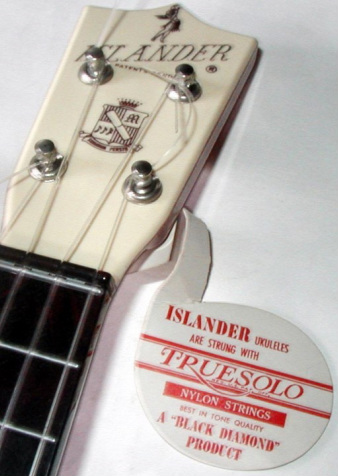
The Islander soprano came in three models. A base model, a Semi-Deluxe, and a DeLuxe. They all had metal friction tuning pegs, the same basic body shape and were equipped with strings made by DuPont. They did have some different styles of head plate designs as well as bridge covers and sound hole ring variations. A multitude of colors were represented. The basic Islander was sold for $4.50.
Within the crest you can see the Maccaferri "M" and three notes. The item going diagonally is a reed representing his French American Reed Company. In the small banner beneath the crest it says "Summum Persto". Summum means above/high. Persto means persist/remain strong. After studying Mario Maccaferri's life I imagine this motto helped him get through many ordeals.
Photo used by permission from Ebay seller.
Within the crest you can see the Maccaferri "M" and three notes. The item going diagonally is a reed representing his French American Reed Company. In the small banner beneath the crest it says "Summum Persto". Summum means above/high. Persto means persist/remain strong. After studying Mario Maccaferri's life I imagine this motto helped him get through many ordeals.
Photo used by permission from Ebay seller.
A Veritable Rainbow
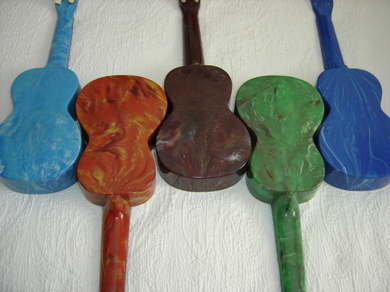
The original color was "simulated rosewood". It didn't take long for a rainbow to appear. Because of the unpredictable nature of mixing colors in the injection molding process every color became one of a kind. Some look striated while others look speckled.
Photos from my collection.
Photos from my collection.

This photo was used by permission of Ebay Seller. It is a wonderful example of a mottled yellow.
Injection Molding
If you are not familiar with how injection molding works here is my description: Plastic pellets of a chosen color are loaded into a hopper which feeds the molding machine. These are heated in order for the machine to inject under pressure the melted plastic into a steel mold. The steel mold is in two pieces with the plastic becoming the meat of the sandwich. In the metal part of the mold there are actually circulated cooling liquids which help the plastic to cool in order to eject it from the mold. Pins in the mold push the product out of the mold. On this photo you can see the round injection pin mark at the neck heel. Hand trimming may be needed if there is some overflow in the seams of the mold. The amount of time to inject the plastic, the time to cool it as well as injection pressure have to be carefully monitored because they can all have adverse effect on the finished product. The manufacturing engineer has to take all of these things into consideration while designing the mold. It is not as easy as making a Jello salad, but there are some similarities.
Injection Molding
If you are not familiar with how injection molding works here is my description: Plastic pellets of a chosen color are loaded into a hopper which feeds the molding machine. These are heated in order for the machine to inject under pressure the melted plastic into a steel mold. The steel mold is in two pieces with the plastic becoming the meat of the sandwich. In the metal part of the mold there are actually circulated cooling liquids which help the plastic to cool in order to eject it from the mold. Pins in the mold push the product out of the mold. On this photo you can see the round injection pin mark at the neck heel. Hand trimming may be needed if there is some overflow in the seams of the mold. The amount of time to inject the plastic, the time to cool it as well as injection pressure have to be carefully monitored because they can all have adverse effect on the finished product. The manufacturing engineer has to take all of these things into consideration while designing the mold. It is not as easy as making a Jello salad, but there are some similarities.
A Ray of Sunshine!

Bao Pham from Montreal, Canada owns this nice bright yellow Islander. He says it reminds him of his daughter Felicia because it just shines! The uke is a semi-deluxe model with the spur design bridge cover. Thanks for sharing the picture Bao!
Compare this yellow to the one above, which is not as bright yellow and seems to have some green speckles while this one has more red and white striations.
The yellow one below is unusual for a couple reasons. The ukulele is all one color; top back and sides are this soft canary yellow. It is the only one like it that I have seen. I am sure there were more made because it would have been too costly for a mold to run one of a single color. This particular ukulele was repaired with a badly bowed neck that was caused by heat.
(from my collection)
When you look at these three different yellow Islanders you can see what a variety there were.
Antoine's "Apocalypse Now" - It ain't easy bein' green!

Antoine from chordmaster.org sent me this photo of this incredibly patterned green Islander he bought. He says, "I removed the rust, removed a small red spot with alcohol, removed a enormous orange ghost on the front by sanding (due to having left adhesive tape on the table it during years)
sanded the front and the back to remove scratches, then buffed them, and waxed the baby with carnauba. Then put new strings and it sounds incredibly good." If you want to know how Antoine does his repair work- go to his website ChordMaster.org (linked down below). Prepare to be amazed!
sanded the front and the back to remove scratches, then buffed them, and waxed the baby with carnauba. Then put new strings and it sounds incredibly good." If you want to know how Antoine does his repair work- go to his website ChordMaster.org (linked down below). Prepare to be amazed!
A "who could be blue"?
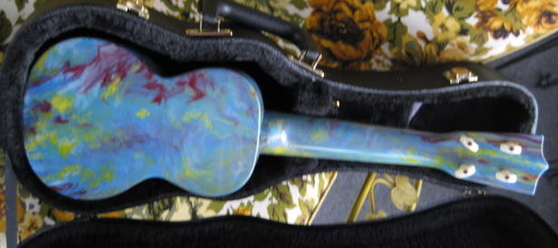
Gary Creed was kind to let me share the photo of this crazy blue multi-colored Islander he owns.
In the pink with this De-Luxe--
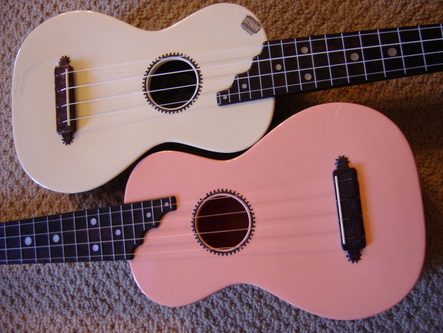
I have never seen an Islander with a top and the headstock plate that was pink! I took the picture next to the standard ivory color to show the difference. The back of this pink topped Islander is a nice bright red.
photo from my collection-
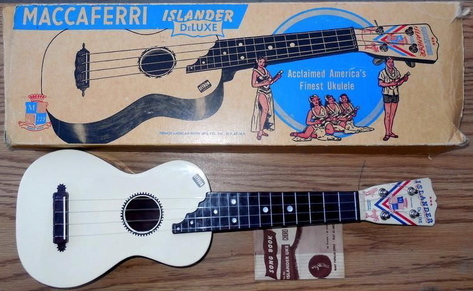
Here is a
near mint DeLuxe model with the original box. Three Photos used with permission of Ebay seller.

Here is a photo of four "DeLuxe" models.
Two of them you will notice are
TV Pal DeLuxe and two are Islander DeLuxe.
The TV Pal DeLuxe are different from each other
in that one has the extended fingerboard and the other doesn't. I think the one with the standard fingerboard could be a rare factory anomaly.
Perhaps someone installed the wrong part or
Specs were changed at sometime.
(Photo from my collection)

Here is the only Islander
I have found that has an
ivory colored fingerboard and
bridge cover. The text on
the headstock is done in
a gold color shade. The back
of the uke is the same "rosewood"color as the top.
(from my collection)
Once in a Blue Moon...

This amazingly
rare all blue soprano
is owned by
Barry Hark of Venice, Florida.
While most Islander tops
are the creamy color,
this whole ukulele's top,
back and sides,
are all this amazing
bright robin's egg blue.
Some different Headstocks
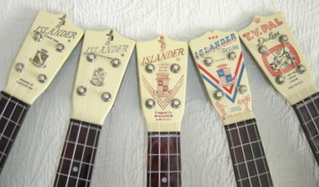
As you can see there were some detail differences on the headstock. The shapes were the same except for the DeLuxe Islander which has a mustache or open book style top edge. The graphics were different on the various models as well. The one on the far right is a T.V. Pal DeLuxe which has metal friction tuning pegs instead of the plastic that most T.V. Pals had.
Photos from my collection.
Photos from my collection.
More details
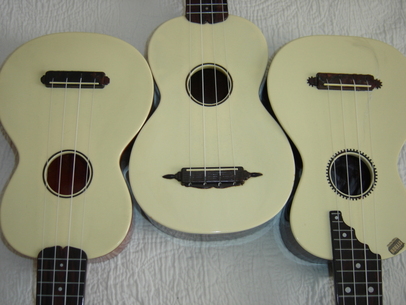
Here you can see the different bridge cover details. The basic bridge is kind of a deco squared look. The next is tapered to points and on the next you can see it has what I call a spurred design. The sound hole ring on that DeLuxe also has a sprocket look to it. The Islander DeLuxe also had the extended fingerboard.
Photos from my collection.
Photos from my collection.
Below is a photo of Mario Maccaferri demonstrating the benefit of plastics
by totally submersing an islander in a water filled aquarium.
by totally submersing an islander in a water filled aquarium.
Islander Nylotone Strings
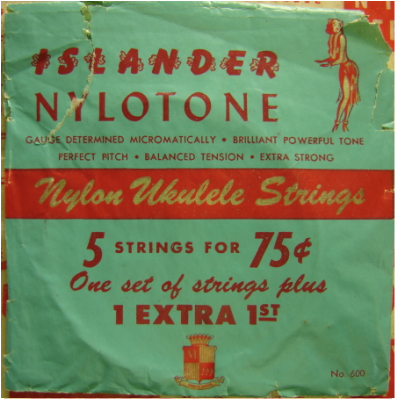
The amazing thing with these strings is it came with an extra 1st string- 5 strings in one set. Explaining that the extra first string was included because it was the one most likely to break due to it being thinner in diameter.
You can read the rest of the wrapper on the photo below.
Photos from my collection.

The photo at right is courtesy of
Ebay seller "lucysukuleles".
As you can see they are Cole's Patent Pegs No. 203 and were made for not only Maccaferri Islander, but some Kamaka's as well. The diameter of the hole is too small on an Islander for a modern peg and if you were to try to drill it larger it could be disastrous for the uke. Peg replacements now are usually found on badly damaged Islanders. As you scroll down you will see a box of Islander Baritone Uke Pegs distributed by Mario Maccaferri's company (French-American Reeds), but I have not yet seen a box specifically marked as a
"Soprano Islander Peg".
The Islander Key Adjuster
Islander ukuleles came with this tag attached to the "Tune Tite" tuners with the
"Key Adjuster" tool to maintain tension on the tuning pegs. I guess 99%
of these tools were lost and it's a good thing that a small
screwdriver can be used for this purpose.
Here is a picture of one in the original bag with the 'ukulele
and one on the opposite side of the card.
"Key Adjuster" tool to maintain tension on the tuning pegs. I guess 99%
of these tools were lost and it's a good thing that a small
screwdriver can be used for this purpose.
Here is a picture of one in the original bag with the 'ukulele
and one on the opposite side of the card.
Islander Baritone Ukulele

The baritone ukulele headstock is similar to the "DeLuxe" soprano and it has a nice cutaway body. Photo used by permission from guitarz blogspot. Baritone Islanders were sold for $12.95.
Listen to one here. (and here)
The pic above is an original box of baritone tuning pegs. (my collection) Below is a slide show of a very rare electric baritone. As you can see it came packaged with an amp included. This was from new old stock and pictures were used with permission of Ebay seller. (just click to view photos.)
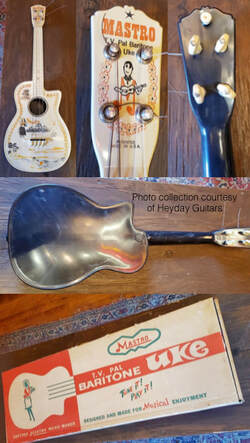
This photo collage shows a
very unusual TV Pal baritone
ukulele. It is highly graphic
with a Polynesian theme- even
a lei design on the headstock
front plate.
You can see there is a strap button
on the back of the headstock.
(Special Thanks to Heyday Guitars
of Winston-Salem, NC, for use of
their photos.)
Sparkle Plenty and other ukettes

The Sparkle Plenty Ukette was a smaller version ukulele - about 15 inches long. It was designed for a smaller child to be able to learn to play. Sparkle Plenty was Dick Tracy's daughter in the Dick Tracy comic strip. The Sparkle Plenty Ukette has graphics of Dick Tracy characters on the ukulele. It used plastic pegs for tuners. Some of us may remember seeing them advertised on the backs of comic books. They cost $2.98. The basic ukette had no special graphics and was sold for 85 cents. Can anything this small actually be used to make music? Listen to an Islander Ukette here.
Listen to a Carnival ukette here.
These photos were used by permission of Ebay seller.
Listen to a Carnival ukette here.
These photos were used by permission of Ebay seller.
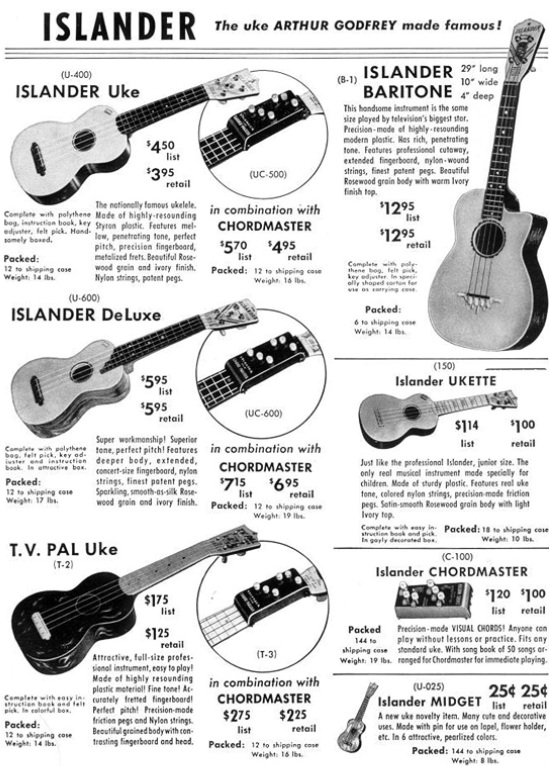
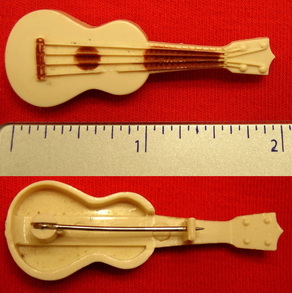
In the advertisement above you will see the "Islander MIDGET" advertised as a novelty item that was sold for 25¢.
I thought the pin in the photo to the left may have been a MIDGET until a friend sent me the picture of the one he bought from a flea market contact. See the photo below at what the elusive MIDGET pin probably looks like. This one is pink.
The cover and inside back flap of a Roy Smeck book.
Maccaferri Guitars

The next two photos are examples of Maccaferri guitars. (Permission from guitarz blogspot). The tail piece on the jazz guitar is a signature Maccaferri as his design in the Selmer-Maccaferri guitars. The G40 DeLuxe Arch-top (shown) was $39.95 and the G30 guitar without a tail piece (not pictured) was listed for $29.95.
Listen to one here.
The "Romancer" (below) has some wonderfully cheesy graphics and sold for $12.50.
Listen to one here.
The "Romancer" (below) has some wonderfully cheesy graphics and sold for $12.50.
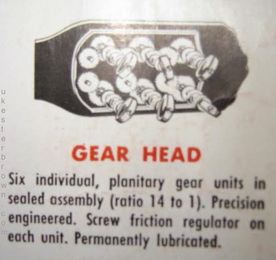
One of the ingenious innovations
that Mario Maccaferri used in his
plastic guitars were these geared
tuners. The gears were concealed
in the headstock and appeared as
friction tuning pegs.

Here is a photo of a
disassembled
geared headstock
of a Maccaferri Guitar.
The Flat Top Islander Guitar
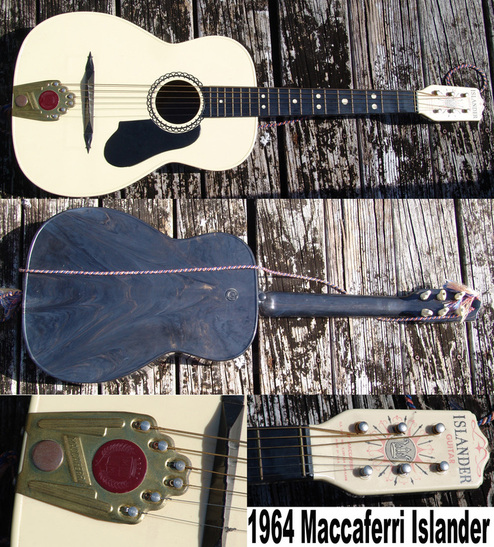
This photo was shared by
Dale Harley.
In 1964, this guitar came in a polythene bag with a carrying box and sold for $19.95.
Note the headstock shape is the same as the Romancer guitar pictured above.
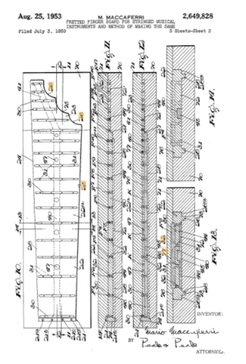
Many wonder why the frets and fingerboards were so strong. The answer of course is in design and material. In design (from what I understand) the fingerboard was made in a 2 step process. First the frets and fret markers were made like a spine in one unit. This fret/marker spine was then over molded with the the rest of the styron material to make one fingerboard. The material was different also as stated in the patent. The "fret forming material is a polystyrene plastic to which has been added a metallic powder, say for example a mixture of aluminum powder and copper powder, to form a plastic mixture of which the metallic powder mixture constitutes approximately 5% to 20%. Such polystyrene is preferably of the natural colorless crystal form and when metallized with the aluminum and copper, the resulting plastic has a silvery or copper-like color." Simply put- metal powder in the plastic made it stronger.
Maccaferri Plastic Violin
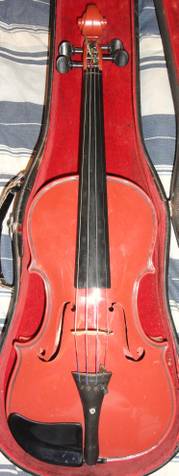
Here are two photos of the Maccaferri Violin.
Mario Maccaferri was 86 years old when he took on the project of creating full scale, concert violin made of plastic. He hand produced approximately 500 of these. From what I've read he invested $350,000 on this project.
In the lower photo you can see the Maccaferri label through the sound hole. (Photos used with permission of Ebay Seller.) This violin sold on Ebay for $560.00 in October, 2011.
You can hear one played here.
For more information on these read this.

If you had the spirit of
the do-it- yourselfer
you could have gotten
the violin as a kit.
Photos used with
permission of the
Ebay seller.
Friction Pegs - Check out the "M"
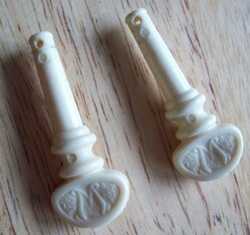
There were a variety of instruments made with friction pegs- including the T.V. Pal Guitar. There is no doubt who made these when you see the great stylized Maccaferri "M". This same "M" can be seen on the tuning knobs of the Maccaferri Baritone Ukulele and guitar friction pegs that have the metal shaft. Some of those were done in a pearly silver and a burgundy color.
This photo used with permission of Ebay seller.
What in the world is a Uke Player or Chord Master?

Uke Players and Chord Masters are devices which attach to the neck of the ukulele with two rubber straps. There are a set of buttons on the top and with the pushing of one button several strings are held down which allow a chord to be played. Note that on the Islander Chord Master (below) that "standard tuning" is noted and that the chord shapes designated makes the standard tuning ADF#B. The Islander model also has the chord names elevated and angled to make it easier to read while using the device.
If you have more questions about these devices go to ChordMaster.org The site has a virtual Chord Master which allows you to play it on your computer. It also has a wonderful collection of photographs and information.
See a Chord Master being played on an Islander ukulele here.
There is an advertisement photo below bragging up the ability of the Uke Player having you playing like a "Pro" without lessons.
If you have more questions about these devices go to ChordMaster.org The site has a virtual Chord Master which allows you to play it on your computer. It also has a wonderful collection of photographs and information.
See a Chord Master being played on an Islander ukulele here.
There is an advertisement photo below bragging up the ability of the Uke Player having you playing like a "Pro" without lessons.

Now there is a company making a chord changer and it is helping people with physical limitations make music. Mrs Maccaferri gave them the patent for the Chord Master. (She has since died.) They have made improvements including adding a D and a G chord button so it now plays songs in 4 different keys. You can learn more about them on Facebook or on the Chord Changer website.
More places with information about Mario Maccaferri:
French American Reeds where it all started.....
Mario Maccaferri's grandson has recently started a website chronicling Mario's legacy and it is very good. You will definitely learn a lot more clicking here. It has a collection of links to his many patents. I am so glad someone in his family is compiling this information.
Nalu Music ukulele arcade : The late John King's scholarly site
The National Music Museum
Django Books has a very good biography.
Catfish Carl and better living through plastics. He has pictures of more than Islander plastics.
Chord Master What started as a unique site about the "Chord Master" gadgets has quickly become probably the best internet site about plastic ukuleles. LOTS of photos!!
How do a variety of plastic ukuleles sound when played by a variety of players? Hear and See
Mario Maccaferri's grandson has recently started a website chronicling Mario's legacy and it is very good. You will definitely learn a lot more clicking here. It has a collection of links to his many patents. I am so glad someone in his family is compiling this information.
Nalu Music ukulele arcade : The late John King's scholarly site
The National Music Museum
Django Books has a very good biography.
Catfish Carl and better living through plastics. He has pictures of more than Islander plastics.
Chord Master What started as a unique site about the "Chord Master" gadgets has quickly become probably the best internet site about plastic ukuleles. LOTS of photos!!
How do a variety of plastic ukuleles sound when played by a variety of players? Hear and See
Do you have questions about an Islander ukulele or have one you want to sell?
I am always interested in buying Islander ukuleles, especially if they are a unique color. If your Islander is badly broken I am also interested in buying the tuning pegs/knobs. If you have one of these ukuleles, some tuning pegs or a question about these ukuleles contact me, I'd be more than happy to try to help you.
Here's a slide showing different features-
Below is a Maccaferri Islander in it's happy place.
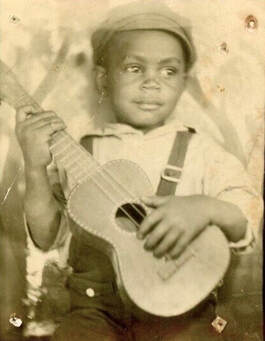
This photo shared by "lucysukuleles" is a cover of the magazine "The American Weekly" issue September 11, 1955.
The American Weekly was a newspaper supplement published by the Hearst corporation from November 1896 until 1966.
Enlarging the photo gives
evidence by the headstock
that the 'ukulele is a
semi-deluxe model Islander.
Unfortunately, the young lady would rather listen to
Eddie Fisher records than her
collegiate suiter crooning
with his 'ukulele.
A Minnesota Ukulele player sharing what he learns as he learns it...


